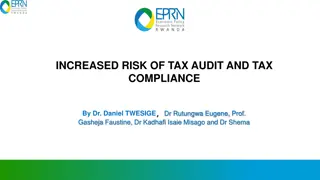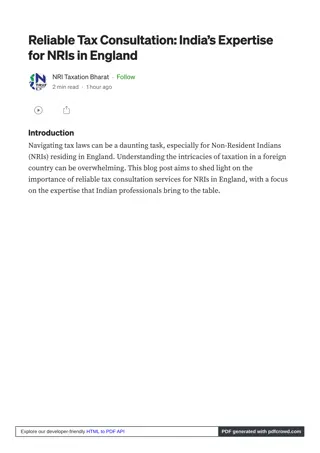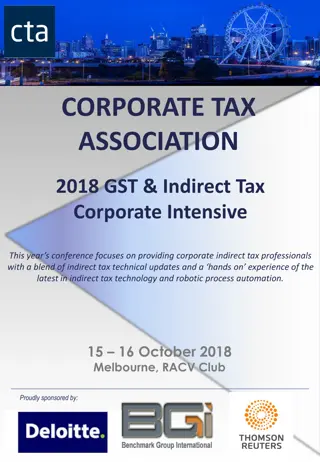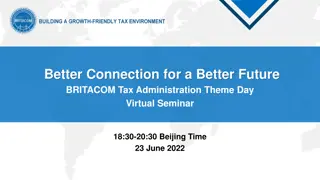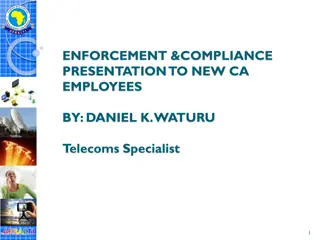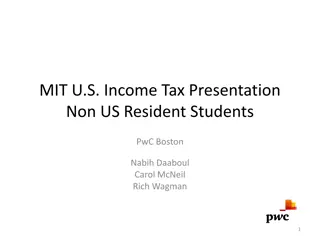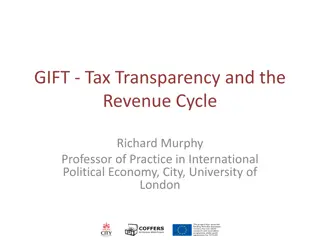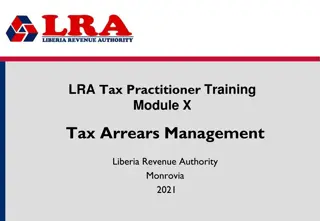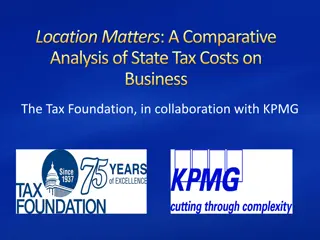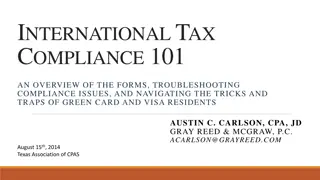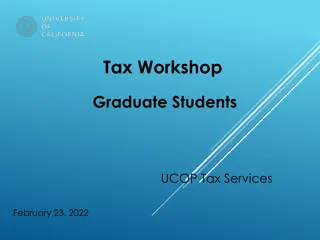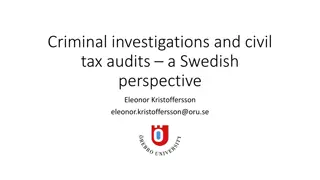National Conference of Enforcement Chiefs: Enhancing Tax Compliance and Enforcement Practices
The National Conference of Enforcement Chiefs held by the Commercial Taxes Department, Government of Andhra Pradesh, focused on nurturing tax compliance, targeting evasion cases, preventing harassment, and overseeing tax administration to curb high-pitch demands. The enforcement wing emphasized data analytics, human intelligence, and return scrutiny for case selection. Analyzing taxpayers' profiles included various parameters like registrations, turnovers, interest liability, and sectoral analysis. The effectiveness of analytical reports was showcased through completed cases and demand figures. Additionally, collections from enforcement actions and the impact of sectoral analysis on analytical reports were highlighted, leading to the identification of outliers and actionable insights.
Download Presentation

Please find below an Image/Link to download the presentation.
The content on the website is provided AS IS for your information and personal use only. It may not be sold, licensed, or shared on other websites without obtaining consent from the author. Download presentation by click this link. If you encounter any issues during the download, it is possible that the publisher has removed the file from their server.
E N D
Presentation Transcript
National Conference of Enforcement Chiefs on issues in Enforcement and Best Practices Commercial Taxes Department Government of Andhra Pradesh 04-03-2024 1
Objectives of Enforcement wing Nurture Tax-compliance among Taxpayers. Better Targeting of the Cases to curb evasion. Avoid harassment to Taxpayers. Oversight on Tax-administration to prevent high-pitch demands. 2
Selection of cases for Enforcement 1. Data Analytics Taxpayer Level Profile of the taxpayer is analyzed based on the tax paid and turnover particulars utilizing historical data. Sectoral Analysis Profile of the taxpayer is analyzed through data modelling with respect to his sector. 2. Human Intelligence Cases identified through local intelligence. 3. Based on Return Scrutiny Cases identified through return scrutiny.
Analysis of taxpayers Profile Registrations Registration Alerts GSTR-1 vs GSTR-3B TDS vs GSTR-3B Turnovers Ineligible ITC / ITC Reversal GSTR-3B vs GSTR-9 TCS vs GSTR-3B Turnovers ITC Spike Analysis Interest Liability Returns Sectoral Low cash-to-liability ratio Large B2C Transactions Service Sector ITC Restriction Profit Ratio Analysis under the Service Sector GTA with excess ITC claim Import & Export E-way bills E-way bills cancellations E-way bills vs GSTR-3B 3rd party data Turnover comparison
Effectiveness of Analytical Reports No. of cases completed Analytical reports Demand (In Crore) S No False Positive Strike rate % 54 18.23 2361.73 28 65.86 89.99 87.69 87.06 88.46 85.71 1 2 3 4 5 6 Registration Returns Sectoral Service Sector E waybills 3rd Party Data 2517 252 65 5.2 8 201 150 189.95 23.63 10.74 2609.48 26 18 7 1 Total 2994 333 88.88 Avg : 87 lakhs per case 5
Collections from Enforcement actions (since Oct 2022) Inspections Rs.433 Crores Audits Rs.202 Crores Total Collections Rs.889 Crores Scrutiny of returns Rs.254 Crores
Effectiveness of Analytical Reports based on Sectoral Analysis Impact of 5 new Analytical Reports Outliers identified Action Initiated 1. Top Sectors Analysis 2. Top taxpayer analysis 1600+ Return Scrutiny 3. Main Trading Partner Analysis 700+ 4. Inter-State Trade Quantum E-Way Bill Audit 5. IGST inflows and outflows 500+ Inspection 7
NGTP Modelling The Non-Genuine Taxpayer report helps identify that are registered in the last 6 months and to take up required enforcement action. State jurisdiction taxpayers Newly registered TPs in the last 6 months are considered Trade name as traders/enterprises included Proprietor/Partnership concerns considered Included TPs dealing in evasion-prone goods/services Passing ITC of more than Rs.25 lakhs within 6 months of EDR Exclude public/private limited and manufacturing units Parameters for NGTP Flags for NGTP Aadhar authentication Bank Account details not submitted Number of RCs with the same PAN Cash to Liability Ratio Fake RCs with same PAN 1 1 1 42 cases closed 1 82 cases allocated NGTP s 332Cr Revenue Identified in closed cases NGTP Model 0 0 0 0 0 From 2022 till now Genuine Execution
State Monitoring Committee Case selection and allocation State Monitoring Committee (SMC) Headed by the Chief Commissioner of State tax and 2 Senior officers of the department. Allocate cases based on combination of different parameters. Tasks are generated to the Proper Officers through online. All enforcement actions are automated and processed through system. Cases are referred based on outliers identified through analytical reports or human intelligence. Information of the taxpayers for 32 parameters and mismatches send to SMC through online automated process.
Automated system for selection of cases 1/2 11 Step 1 Step 4 Cases referred by the field formations based on local are examined by the SMC and also is done through online only. System automatically recommend the cases with required type of investigation based on the mismatches of the taxpayer data. intelligence Step 4 Step 5 allocation Step 1 Step 2 Step 5 Selected cases will be integrated the workflows and monitored time APCTD dashboard. Step 6 Entire process of identification, selection authorization done online. State Committee will cases and the investigation. Step 3 Monitoring (SMC) examine with the in through executive real select cases for Step 2 Step 3 Step 6 SMC will allocate the cases to the authorized for further action. and officer is through
Oversight on Enforcement Action APCTD developed automated work-flow for all processes including Audits/ Investigations/ Return Scrutiny. Every step of investigation is monitored on real time role-based dashboard. Established State and Regional Investigation Monitoring Committees to examine the Investigation-findings arrived by the Proper officers to ensure uniformity and to avoid high pitch demands. Based on threshold of the tax identified, cases are referred to the State (more than Rs.1cr ) or Regional Monitoring Committees (Rs.10 lakhs to Rs1Cr). Committees periodically review the tax proposals for their legal validity and issue suggestions for any short fall in the findings etc., The cases are sent to the Proper officers with specific remarks of the committee.
Quality of Investigations Avoidance of high pitch demands. Ensure quality of enforcement actions - closely monitored through internal workflow and online system by checking effectiveness ratio reports. Proper Officer enters the data after completion of each milestone in the process of investigations and scrutiny. For example: In Audit Audit ratio = Amount as per ADT02 + Amounts paid before ADT02 vs Discrepancy notice amount Adjudication ratio = Demand in DRC-07 Vs Demand proposed in ADT -02 Collection ratio = Amount Collected vs demand raised Similarly, measuring effectiveness ratios for inspections and scrutiny of returns. 13
Recovery Asset management module: Assets details of the defaulters are identified by integrating other govt department data bases (Property Tax, Land, RTA, Electricity). Movable assets (vehicles) and immovable assets (agricultural lands, plots and sites etc.,) of the defaulters are identified in real time. Recoveries made: 387 Cr (since Oct 2022) against 1716 Cr of collectable demand Prosecution ordered in 9 cases. Arrest provision is sparingly used. Fake registration racket dealing in granites and Iron Scrap was busted. Arrested 5 kingpins in the said racket.
Issues in Enforcement to achieve the core objective Sankalan : Modus operandi of DGGI cases may be shared with States Additional Data required to develop effective Data Analytics/Modelling e-Invoice data, ICEGATE, Toll Plaza data, AS26, other State s data (wherever required). Need for continuous capacity building: Knowledge on the implementation of GST for tax officers is not comprehensive. Need for training on collection of Human intelligence by DGGI 15
Thank You Thank You
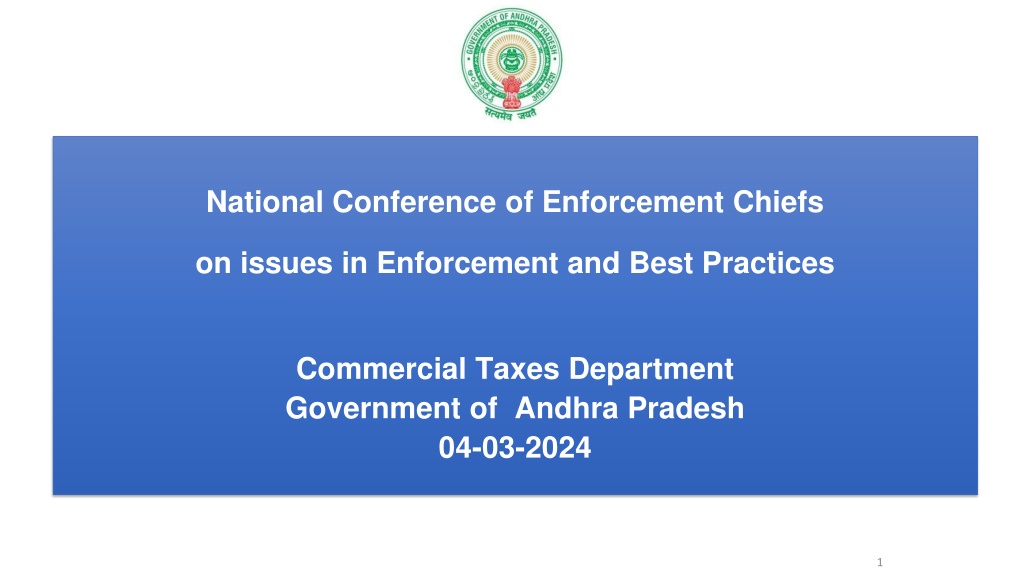


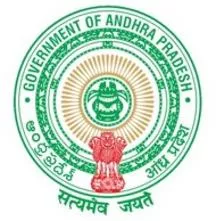




![Town of [Town Name] Real Estate Tax Rates and FY 2024 Budget Summary](/thumb/62211/town-of-town-name-real-estate-tax-rates-and-fy-2024-budget-summary.jpg)
